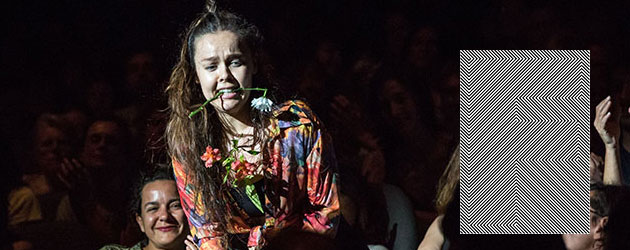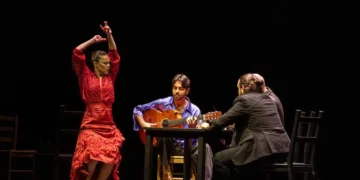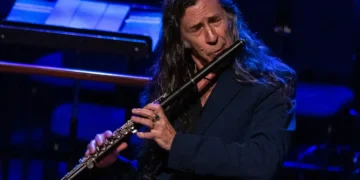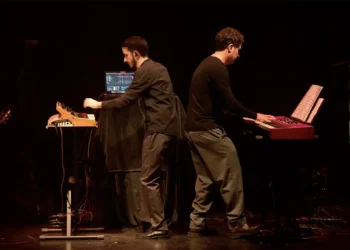Silvia Cruz Lapeña
The strong points were Rocío Molina?s new show, and Dani de Morón?s concert at the Auditori.
The festival Ciutat Flamenco has extended its length and broadened its presence, something which was becoming inevitable in order to be able to refer to the event as a festival of this city. Using venues such as the Auditori, the Tradicionàrius and the National Library is a decisive step forward so that flamenco followers can feel that Barcelona is flamenco and has a place for being so.
The kick-off with “Caída del Cielo” of Rocío Molina, couldn’t have been better. All sold out since months ago, and people at the entrance literally begging for a ticket, showed the degree of expectation generated by the Málaga dancer. There were some errors in the execution, but the staging caused an impact, as did the complexity of the work and the repertoire of movements put on the stage of the Mercat de les Flors of Torre del Mar. Molina’s ability is unquestionable, and what her body is capable of, something she demonstrated at a flashmob in which she also showed her gift of communication.
“Es la Hora” was another show presented at the Mercat. The work is directed by an ex-member of La Fura del Baus, Hansel Cereza, who demonstrated his command of the stage, lighting and other details of a sober but efficient project. The story-line, which began slowly from the moment in which bullfighters get ready to go out into the bull-ring, was devoured by Eli Alaya, a dancer with great facial and body expression that goes beyond any dance school learning. The power of her legs ate up the stage, in the most positive sense, we all wanted to see more of her, and in other registers.
At the Mercat de les Flors, José Manuel Álvarez danced, accompanied by the percussion of Lucas Balbo in a ‘performance’ with which the Catalonian reflected on the manner in which he manages the flamenco journey from traditional to modern. He had people enthralled from the very first moment, and barely 20 minutes was all he needed to be worthy of the audience’s enthusiastic ovation.
Dialogues
In this edition, the idea of having flamenco dialogue with other, more or less distant artistic manifestations, was interesting. This was done in the double concert that included a recital of Antonia Contreras and Juan Ramón Caro, and another of Valencia singer Josep Aparicio “Apa”, between one and another, and without needing to mix them together, the common bond of flamenco with other musical forms from the Iberian Peninsula was made evident. It was more than educational to feel bulerías and malagueñas adapted to the powerful voice of the Valencia interpreter, and hearing the differences compared to flamenco versions.
What does not work as well is the format of the double concert, mostly due to the lack of interest or habit of the audience, than to the organization, although in this case the program made sense because between both concerts, it ended up being a music lesion. Antonia Contreras gave a classic recital in which she was especially good with soleá, and won over the audience with tangos in the style of Enrique Morente. Caro, playing ever so sweetly, was on his own turf which perhaps was why he was fussier than usual, leaving less room for the voice of the Málaga singer, winner of the last Lámpara Minera.
That attempt to dialogue made less sense in the case of Auto-Sufi-Ciencia, where Pedro Burruezo put flamenco and sufí music on a stage created for the occasion at the Biblioteca de Cataluña. It’s a beautiful venue, but inadequate: the stage being the same height made problems for an audience that wanted to see what they were hearing, and were constantly moving during the show to try get a look. The music and the intention were beautiful, but beyond some thematic and melodic coincidences, there was little to see of the actual work.
What was really outstanding was the singing of Pere Martínez, who took charge of the flamenco part with perfect pitch, and depth that grows with each moment. It was chilling how he took on the soleá of la Serneta and the taranto of Pedro el Morato. Also noteworthy was the guitar of Marc López who, in both the accompaniment and the solo portions, gave an impeccable performance.
Dani de Morón and the future
If Rocío Molina was a high point at the very start of the festival, Dani de Morón raised the level even more just before the Festival ended. He didn’t fill the house with his concert at the Auditori de Barcelona, but without a doubt it was a night for the history books. Duquende, who shared the bill with Antonio Reyes and Jesús Méndez, didn’t show up, something his Barcelona audience, so fond of him, is accustomed to. But Dani was self-sufficient to win over the audience, among whom there were several professional guitarists and many young hopefuls.
Jesús Méndez pulled his voice up from his feet to sing tarantos, seguiriya and bulería por soleá. Reyes proved to be a magnet for audiences, his voice isn’t so loud, but his power of communication cannot be matched. He started out with alegrías taking full advantage of his honest delivery which enthralls people, continuing with slow patient soleá that Dani accompanied masterfully. He ended with fandangos, standing in showman pose, leaving Dani alone with the Mellis, and ending with a bulería finale in which Méndez did his little dance, delighting the audience. Dani made a few things evident: he has nerves of steel, and is moving because of the sheer accumulation, and in his guitar it’s not so important what sounds today as what he promises, that the future is his, no doubt about it.
There was also room for courses at the Festival, for the exhibition of Ruselito, a young guitar hopeful in the hall of the Mercat, and for the concert given by Pepe Motos at the Centre Civic Besós and a day given over to rumba, Sunday, to wrap up the fiesta. There is no doubt the Festival has advanced in physical space and in the variety of approaches, but in fact it would be a good idea in upcoming editions to see flamenco invented or created by women, who number as many as the men, although in this edition the offering was limited to Molina’s work and the voice of Contreras.
Fotos: Maud Sophie Andriueux (Galeria completa)





























